Sharlyn J. Lauby's Blog, page 90
October 29, 2019
Free HR and Payroll Learning Opportunity: Kronos Fall eSymposium

(Editor’s Note: Today’s article is brought to you by our friends at Kronos , a leading provider of workforce management and human capital management cloud solutions. The Workforce Institute at Kronos has a new book out, “Being Present: A Practical Guide for Transforming the Employee Experience of Your Frontline Workforce”. Learn how you can get a free copy in today’s article!)
I’d
like to think that by now I don’t have to tell you about the importance of professional
development. That being said, I do realize that understanding the importance
of development and making it happen are two different things. As human
resources professionals, we’re often so focused on everyone else’s development
that we forget to schedule time for ourselves.
That’s
why I wanted to share with you some specifics about this FREE event from our
friends at Kronos. The Kronos Fall HR and Payroll
eSymposium is scheduled for Wednesday, November 20, 2019 from 10a to 5p Eastern. As someone who has attended Kronos
conferences and their eSymposium in the past, I can speak from experience that
Kronos delivers quality professional development. But before I share some highlights from the agenda, I want to talk
about some other reasons you should attend.
3 Reasons to Register for the Kronos Fall eSymposium
This
one-day eSymposium is designed to bring HR and payroll professionals education
on the topics we deal with every day. The event will offer three tracks – basic,
intermediate, and advanced – so you can attend the sessions that align best
with your career. Personally, I must admit
that like the flexible format. I can follow one track or switch back and forth
to explore the topics. But there are three reasons that an event like this one
really makes sense for human resources and payroll professionals.
REASON #1 – Quality programming that’s relevant to our profession. There have been a few
times in my career when I’ve been responsible for both human resources and
payroll. I see hosting an event that brings together both payroll and HR as a huge
selling point. Because the event is free, organizations can bring
everyone together, order lunch, and listen to the sessions as a group. Also,
the eSymposium is a good way to encourage HR pros to learn more about payroll
and vice versa.
REASON #2 – Recertification credits. Let’s face it,
recertification credits are important. Most of the sessions have been pre-approved by
the Society for Human Resource Management (SHRM), the Human
Resources Certification Institute (HRCI), and the American Payroll Association. Kronos will be providing a certificate of participation
for your files. So, if you’re certified, this event is a no-brainer. It covers
the learning trifecta: 1) high quality, 2) no-cost, and 3) approved for
credits. This doesn’t happen very often.
REASON
#3 – Recordings.
The beauty of the eSymposium format is that there will be recordings of each session and you’ll be able to download
any session materials. So, if you’re not able to listen to the live sessions on
November 20 OR your learning preference is to space your listening out over
time, then you have that option. I especially like this when there are two
topics that I want to hear and they’re both offered at the same time.
The
Kronos Fall eSymposium Agenda
Now
that you know how easy it will be to participate in the eSymposium, let’s talk
about the agenda. I got a sneak peek into the sessions being offered and here
are five that caught my eye, for both HR and payroll professionals at every
level of the organization.
2019 Employment Law Update – With new
Fair Labor Standards Act (FLSA) changes on the horizon, I know this will be a
popular session. During this session, Burton D. Garland, Jr. with Ogletree,
Deakins, Nash, Smoak & Stewart, P.C. will: (1) review the significant
changes that have taken place in recent years; (2) discuss the current state of
employment law and anticipated changes (including EEO developments, leave laws,
ADA updates, and examples and case studies); and (3) suggest ways to be
compliant with these changes. If employers have not already done so, they
should review and revise their policies and procedures to ensure they are in
compliance with these changes.
The Cost of Doing Nothing: Mistakes I’ve Made So You Don’t Have To
– Join
Julie Develin, SHRM-SCP as she takes you through a “tell all” about lessons she
learned from her experience leading HR during a time of change. Using real
world story-telling examples and solutions implemented as a guide, she’ll share
some of the challenges she faced, common mistakes she made, and ways she
overcame them. Learn how to critically evaluate your HR processes and identify
opportunities for improvement and advancement both within HR and for the
broader organization as Develin talks about the choices HR leaders make that
can hold organizations back from reaching their strategic business objectives
and achieving a winning workplace culture.
People
Analytics Gets Real: How HR Leaders Leverage HCM Insights – People
analytics is an inescapable topic in the modern human resources and business world.
There are so many methods for getting descriptive, predictive, and even
prescriptive insights. The question becomes, how do all those insights become
actions that we can take to help our employees and meet business goals? Well, this
session is here to show you. Join Chris Mullen, Ph.D., director and strategic
advisor at Kronos, as he hosts a conversation between a technical expert and an
HR business leader to demonstrate how what you see in your human capital
management (HCM) system can inform what you do to be strategic in HR.
Unleash Your Strategic Payroll Potential Using the Latest Trends
from APA Research – How strategic is payroll at your
organization? According to the latest American Payroll Association (APA)
research, most payroll professionals view themselves as strategic, but most
executives view payroll as a tactical function. Changing the perception of
payroll can have a powerful impact on business objectives. Join Rachel Rapoza,
Kronos product marketing manager, in this session to learn how to demonstrate
the real business value of payroll, the role technology plays in supporting
payroll’s strategic initiatives, and how HR and payroll can provide the
organization with critical business insights.

The Future of Work
Lastly, I certainly hope you will take a few moments
to join me and the Workforce Institute board for a discussion focused on “Are You Ready for the Future of
Work?”. We will be talking about the importance of workforce development and how to
create strategies that will help organizations find, grow, and keep the talent they
need from the frontlines to the executive suite. I’m also delighted to announce
that as a bonus, all attendees will be getting an e-version of
the Workforce Institute’s new book, “Being Present: A Practical
Guide for Transforming the Employee Experience of Your Frontline Workforce.”
Now of
course, this isn’t the entire agenda. It’s just a sampling of the great sessions
being offered. So, don’t dilly dally around. Sign up for the Kronos Fall
eSymposium. Focus on you. Get the learning and the free ebook. Here are the
deets:
Wednesday, November 20, 2019
10 a.m. to 5 p.m. Eastern
Look forward to seeing you there!
The post Free HR and Payroll Learning Opportunity: Kronos Fall eSymposium appeared first on hr bartender.






October 27, 2019
Change Management Thrives When We Take Time to Stop
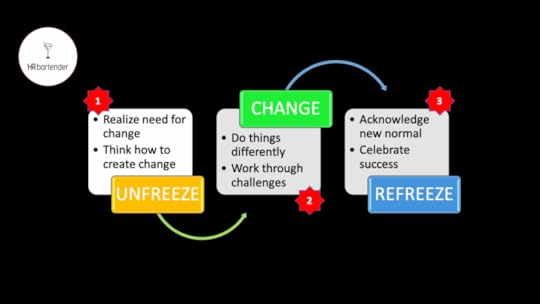
A few months ago, I published an article about Change Management: A 3-Step Model. It talked about Lewin’s three-step model for change (unfreeze – change – refreeze). After publishing the piece, I received a note via Twitter.
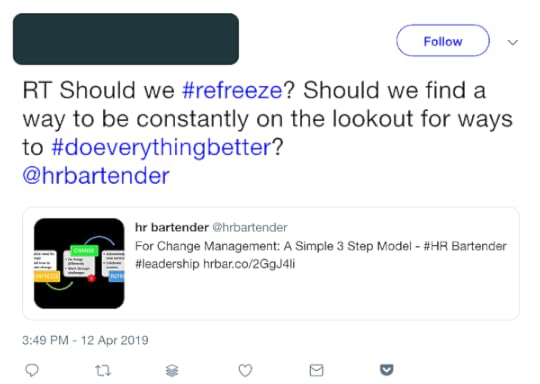
It’s a great question. And the answer to the second part of the comment is Yes! We should be always looking for ways to do things better. But I don’t believe that it means we should eliminate the refreezing phase in change management. Let me explain my thought process.
Refreezing does two things. It establishes the
new normal and allows people to celebrate. If we eliminate refreezing, then we
don’t give people an opportunity to celebrate successfully going through the
change process. And the celebration is important, especially since we’re
dealing with all sorts of changes at the same time.
Celebrating change reminds people that they can do it. They are capable of change. The next time a person needs to deal with change, hopefully they remember the feeling of accomplishment and celebration more than the frustration of the change.
The other thing that refreezing does is establish the new normal, which is equally important in my opinion. The new normal becomes the new benchmark. The new point of comparison in the change management process. Even if it’s for an hour or a day.
Even when we’re going through changes that we
want, like accepting a promotion or moving to a new city, change is hard. Being
unsettled is hard. Refreezing allows us to say, “Ah, at last! No more change.
At least for now.” Even though we all know that another change is right around
the corner. Refreezing is like a temporary moment where we get to take a break.
And I think – no, I know – we need that. Yea, it might be a Jedi
mind trick but that’s okay. For a few days or weeks,
things are calm.
There’s one other thing that refreezing can do in change management. It can allow organizations or individuals to stop and ask the question, “Do we need to change?” Every day, we’re told about better, faster, and cheaper ways of working or living. We can’t do them all. Refreezing allows us to say, “Should we try this? What are the pros/cons?” and compare the answers to our new normal. That doesn’t mean we won’t ever try it, but maybe not right now. Maybe our refreeze state is good enough for the time being.
While change will always be a part of our
lives, we don’t have to always be in a constant state of change. Or at least
not be in a constant state of major change. As individuals, having a few
moments to stop, breathe, and celebrate our success can be exactly the
motivation we need to tackle the next big change coming our way.
The post Change Management Thrives When We Take Time to Stop appeared first on hr bartender.






October 25, 2019
Workplace Language Is Important
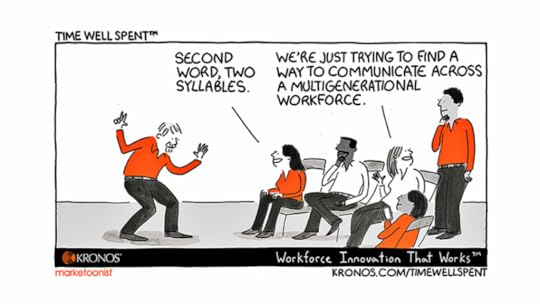
(Editor’s Note:
Today’s article is brought to you by
our
friends at Kronos
, a
leading provider of workforce management and human capital management cloud
solutions. Check out this article on Thrive Global where Kronos CEO Aron Ain
talks about how to “
Stay Humble to Create a Fantastic Work
Culture
.” Enjoy the
article.)
I was recently facilitating the Society for
Human Resource Management (SHRM) seminar on “Leading Workplace Investigations”.
We were discussing a case study where an employee expressed uncomfortableness
when her manager came up behind her at the copier and said “Boo”.
Half of the room thought “Boo” in terms of
Halloween and scaring someone. The other half though of “Boo”
in Urban Dictionary terms as someone you love or care about.
Obviously, they are not remotely similar definitions and we all got a good
laugh. It made the case study quite interesting.
That’s why I laughed when I saw this Time Well Spent from our friends at Kronos. Managers and employees can sometimes feel like they’re in the scene from “The Princess Bride” when Inigo Montoya says, “You keep using that word. I do not think it means what you think it means.” Just like organizational culture, organizations have their own unique workplace language and it’s important for employees to understand it.
Develop a company glossary and share it during orientation. I discovered when I worked for an airline that the transportation industry is full of specific jargon – airport codes, airline abbreviations, unique metrics, etc. We created a dictionary for new employees, so they understood what those acronyms and abbreviations meant. It’s hard for employees to do their job if they can’t decode the message.
Learn new business terminology. I love all the articles that come out when Merriam-Webster adds new words to the dictionary. Their latest additions include vacay and solopreneur. From a business perspective, they’ve also added pain point (a persistent problem) and haircut (a reduction in the value of an asset). At one time retweet was a new term. Same with freemium. It’s important to understand those new terms as part of workplace language so we can stay current with business trends.
Make it safe to botch up a word or phrase. I just listened to an episode of Adam Grant’s podcast WorkLife. This episode focused on The Daily Show’s secret to creativity. You should check it out when you have a moment. At one point, the show writers are talking about how they laugh at themselves when they write or say the wrong word during the development process. The mistake ends up becoming a bonding moment instead of a grammar lesson.
I’m certainly not saying that it’s acceptable to have sloppy work full of typos and grammatical mistakes. But let’s face it, typos happen. Grammar gets messed up. We pronounce words wrong. And we sometimes use words in the wrong context. Not intentionally. But because we’re learning.
Organizations have an opportunity to help employees get their workplace language right. We can give employees workplace glossaries and encourage them to read/watch/listen to business publications to learn new words. Not only will it help with employee development, but it can help employees do their jobs better. Because they’ll understand the workplace language.
The post Workplace Language Is Important appeared first on hr bartender.






October 24, 2019
Employee Benefits: Make Them Easy to Buy and Use

One of my favorite phrases is “make it easy to buy and easy to use”. I learned it years ago in the hospitality industry. If you want to upsell a restaurant guest, make it easy for them to buy the premium product and use it. Basically, as the guest, I simply want to pay and enjoy.
This concept applies to other products and
services too. For example, if you want me to upgrade my technology subscription
then make it easy to buy and easy to use. If I have to logout, download a new
app, reset my password, and it still doesn’t work, then this doesn’t make me
want to spend the extra money.
It also applies to employee benefits. If you
want employees to use their benefits, then they need to be easy to sign-up for
and easy to use. The benefit should also be easy for employees to understand.

A new report from Colonial Life found that 47% of employees who work for companies with fewer than 100 employees understood their benefits package “very well” compared to employees at larger organizations (33%). The report cites organizational commitment toward benefit education being stronger and more personalized in smaller companies.
I’d like to think that I don’t need to tell
anyone that employee benefits that don’t get used aren’t really benefits. What
I mean by that is, the company can have lots of benefit options and they can be
fantastic plans, but if employees don’t use them then it’s hard to explain the
value. The answer is having a benefits program that’s easy to buy and easy to
use. Here are a few things to consider:
Align employee benefits with company culture. When you think about your organizational culture and values, what benefits immediately come to mind? For example, if the company values work-life balance then is teleworking an employee benefit? Or if the company says employee well-being is important, then does the company offer dental insurance? You get the point. And when it comes to benefits, don’t forget that voluntary benefits can be an option.Talk about employee benefits all the time. It’s not enough to mention benefits during an interview or new hire orientation. Employees are processing so much information, they honestly might forget. Think like a marketer and consider having regular employee benefits “coffee chats” or “lunch and learns” so employees can be reminded of how their benefits work. It might also make sense to offer a benefit “one sheet” separate from the employee handbook. This might be something that an employee keeps at their desk or on their refrigerator. Make sure the benefits are serving their purpose. One of the biggest goals that employee benefits serve is helping to attract and retain talent. Managers should be asking about benefits during stay interviews. Benefits should also be asked about during exit interviews. If employees are declining job offers because of benefits, it’s common to say “Oh, they don’t know what they’re doing.” But the truth is…maybe they do. And if employees are resigning for a better benefits package, it might be time to look at a realignment (see #1).
Employee benefits are an important part of the employee value proposition (EVP). But if organizations want employees to feel like they have the best benefits package ever, then they need to market those benefits. And make them easy to buy and easy to use for the employee.
Image captured by Sharlyn Lauby while exploring the streets of St. Petersburg, FL
The post Employee Benefits: Make Them Easy to Buy and Use appeared first on hr bartender.






October 22, 2019
Labor Law Postings: Different Industries Require Different Posters #MindTheGap

(Editor’s
Note: Today’s article is brought to you by our friends at
Poster Guard®
Compliance Protection, a
division of HRdirect and the leading labor law poster service that gets your
business up to date with all required federal, state and local labor law
postings, and then keeps it that way — for an entire year. Enjoy the article!)
A few weeks ago,
I shared with you some history about the term “Mind the Gap” and how we can use
it in a business context. Especially when it comes to labor law posting
requirements. We discussed “3 Employee Groups with Unique Posting
Requirements”:
applicants, Spanish language postings, and remote workers.
Today, I’d like
to add another consideration we need to “Mind the Gap” about: every
organization isn’t the same when we’re talking about labor law postings. Here
are three industry specific labor law posting requirements that companies need
to know.
Industry
Gap #1: All businesses are not the same. Different industries have different
posting requirements.
Currently, there
are six federal labor law posters that most businesses are required to post.
Equal
Employment Opportunity Commission (EEOC)Occupational
Safety and Health Administration (OSHA)Family
and Medical Leave Act (FMLA) Uniformed
Services Employment and Reemployment Rights Act (USERRA)Fair
Labor Standards Act (FLSA)Employee
Polygraph Protection Act (EPPA)
Certain types of
businesses have additional posting requirements. For example, given my
hospitality industry background, I’ve known for years that some states require
restaurants to post CPR and choking assistance information, notices for tipped
employees, and information about alcohol service.
However, I didn’t
realize that health care organizations might have up to 15 additional notices
covering areas such as biohazard materials, radiation areas, and Health
Insurance Portability and Accountability Act (HIPAA) Notice of Privacy
Practices.
In addition, public-sector
employee notices include whistleblower protections, right to know postings, and
information about electronic monitoring. Government agencies also have their
own unique versions of the OSHA and FLSA. My takeaway is that even when it
comes to federal posting requirements, we cannot assume that all organizations
are the same.
Industry
Gap #2: If you have government contracts, don’t forget your Federal contractor
postings.
According to the
Congressional Budget Office (CBO), the United States government spent
$4.0 trillion (and that’s not a typo) in 2017. While a big piece of government spending
goes towards programs like Social Security and Medicaid, billions of dollars
end up with private sector companies. And as you would expect, a big chunk of
those billions go to defense contractors.
However,
according to the Small Business Administration (SBA), 23% of government contracts are
targeted for small businesses. My point being, don’t make the assumption
that only big businesses are federal contractors. Many different types of
organizations have contracts with the government: financial institutions,
technology companies, non-profits, auto dealers, retailers, service
establishments, etc. If you’re a federal contractor, you have posting
obligations. Here is just a sampling of the ten common federal contractor
posters:
Minimum WageNational Labor Relations Act (NLRA)Paid Sick LeavePay Transparency Statement“EEO is the Law” SupplementDepartment of Defense (DOD) Fraud
Hotline and WhistleblowerWalsh-Healy Public/Service ContractsDavis-Bacon ActDepartment of Transportation (DOT) Federal
Highway ConstructionE-Verify/Right to Work
It goes without
saying, but I’ll say it anyway, the penalty for non-compliance isn’t just a
fine. It could be losing your government contract. I’d like to think that, if
your organization has a nice contract with the government, it’s worth your
while to keep it that way (and maintain compliance).
Industry
Gap #3: Companies that have their Federal and State postings, but not their
industry specific ones, are still at risk.
Speaking of fines, it might be tempting to
think that the organization doesn’t need to spend a lot of time worrying about
the “poster police” because the company can simply pay the fine and move on. Someone
might say, “So, what’s the big deal if the company doesn’t have their industry
postings?”
First of all, let’s remember that the purpose
of a labor law posting is to inform
employees of their legal rights (and responsibilities) under federal, state,
and local law.
I hate to admit it, but I’ve actually heard
the chief financial officer of a company suggest not putting up posters because
they were “ugly”. Thankfully, they came to their senses and realized they needed
to focus on the purpose of the posting and their responsibilities as
an employer.
The reason I wanted to bring up the ugly
poster comment is because I’m not naive. I realize that organizations might
have plenty of money to pay a fine. The question becomes do companies want to
pay two fines? Six fines? Ten fines? I spoke with Ashley Kaplan, Esquire,
senior employment attorney for HRdirect, and she told me that the fine for a
federal notice violation could be as much as $35,000+ per location. So, let’s
say that you’re an auto dealer with 4 locations that services government
vehicles. That puts your risk potential at $140,000. Not to mention the
negative public relations if job candidates and employees found out.
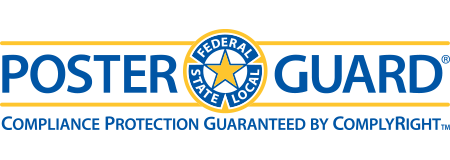
Labor Law Postings: Close the Compliance Gap
What amazes me about these posting
requirements isn’t that labor law compliance is complex. Staying current with
legislation is complex in general. The amazing part to me is that organizations
don’t look for ways to make the process easier. In ComplyRight’s 2019 National
Small Business Compliance Pulse Survey, 62% of small businesses rely on manual
processes to manage these tasks.
It
doesn’t have to be that way. Our friends at
Poster Guard have a Labor Law Poster Service that will do it for you. Yep, that’s right. Poster Guard
monitors labor law requirements (at the federal, state, and local level) and
lets you know when things change. They also provide you with replacement posters every time there’s
a change FREE of charge!
One of the first things I learned as a
consultant was that just because I could do something doesn’t mean I should.
Spending huge amounts of time on manual tasks keeps me from my clients. The
same applies to other businesses. Organizations spending lots of time manually
tracking labor laws keeps them from their customers and employees. That has a
direct impact on the bottom-line.
P.S. Don’t miss our final article in this series where we will talk about the four key elements in developing a labor law posting strategy.
The post Labor Law Postings: Different Industries Require Different Posters #MindTheGap appeared first on hr bartender.






October 20, 2019
Management Development Programs Today Need to Add This Topic

Forgive me for the cryptic title on today’s post. I won’t keep you in suspense. The answer is, management development should include “virtual” management of remote workers.
My guess is that managers are being asked to supervise an increasing number of remote or virtual employees. Even if they only do it on a part-time or sporadic basis. A great case in point – – the news headlines last winter that said, “75 percent of the population will suffer below-freezing temps this week”. My first thought is, if you didn’t have to go into a physical office…why would you?!
Regardless of the reason, when you’re working from home, the company probably definitely expects employees to still get the work done.
That means managers still need to manage. The challenge is that organizations haven’t really spent a lot of time teaching managers how to build relationships with employees, monitor their performance, and coach them when their employees aren’t sitting right in front of them. That’s not the manager’s fault.
Let me repeat that – – – it’s not the
manager’s fault!
I found an article on the Association for
Talent Development (ATD) website about the concept of “virtual
proximity”. The idea being that good managers shouldn’t
let four walls or distance interfere with their ability to manage. I could see
virtual management being a necessary component in today’s management
development programs. For starters, organizations should address these four
areas:
Relationship Building. In a physical office environment, managers can walk by an employee’s desk and immediately engage in conversation. In a virtual environment, it’s different. Managers might want to schedule a quick one-on-one with employees for the sole purpose of building relationships. Recognition. Like relationship building, managers can easily walk up to an employee and recognize them for a job well done. I’m not saying that’s always the right way to give recognition, but let’s face it…managers often do it. Virtual employees need recognition too and managers need to find a way to convey those messages in ways that benefit the employees and the operation. Collaboration. When it comes to projects, virtual employees need to get the same opportunities to brainstorm and weigh-in on ideas as the team working in the office. Collaboration technology solutions can help with this, so no one feels they are being left out of the loop.Technology. Speaking of technology, it’s important for managers to learn about today’s technology tools. Just because we’re talking about managers building relationships with employees and effectively managing their teams, doesn’t mean they can use the help of technology.
It’s time for organizations to realize that managing remote employees isn’t the same as managing the workforce you see every day IRL. Managers should go through management development on the differences and they should be given the tools to effectively supervise both in-office and remote workers.
Image captured by Sharlyn Lauby while exploring the streets of Oklahoma City, OK
The post Management Development Programs Today Need to Add This Topic appeared first on hr bartender.






October 18, 2019
Bookmark This! Workplace Burnout and Stress Edition

According to a survey from Korn Ferry, nearly
two-thirds of professionals say their stress levels at work are higher
than they were five years ago. The reasons cited include increased workloads,
changing technologies, and interpersonal conflicts. Organizations cannot afford
to ignore workplace burnout and stress. It has an impact on employee engagement
and retention. And stressed out managers are eventually going to stress out
their teams.
This edition of Bookmark This! is focused on
offering some insights and information to help organizations and individuals
manage stress in the workplace. I can’t guarantee that it will completely
eliminate anxiety because there will always be an aggressive deadline looming.
But, hopefully, this list of resources will help manage those moments a bit
better.
Worrying
is a Symptom of Employee Stress
– Worrying has been identified as a symptom of
employee stress. Supportive management and comprehensive benefits programs
provide a safe place.
Being
a Nice Person Could be the Source of Your Stress – Is generosity
burnout a thing? Most of us want to be thought of as a nice person by our
coworkers. But can that be a source of our stress?
The
New Cause of Employee Burnout: Always Being “On” – Burnout in the
workplace can have many sources. Long working hours and too much work are great
examples. A new cause may be constant connection to technology.
The
Next Employee Challenge: Loneliness in the Workplace – Loneliness is the
new employee challenge. Dan Schawbel’s “Back to Human” shows managers must work
to develop a connected and engaged culture.
You
Can’t Tell Your Employees to Unplug If You Don’t Do It Yourself – Unplug from
technology is the recommendation from managers to stressed employees. Here are
three things to consider if you want to unplug.
How
to Reduce Individual Stress Levels at Work
– During the BetterWorks Goal
Summit, speaker Srikumar Rao outlined three activities to help reduce personal
and professional stress.
Employee
Burnout: 5 Organizational Programs that Can Reduce It – Employee burnout
is a key concern. Turnover can hurt business success. Learn five proven
programs to help reduce employee burnout.
Employee
Burnout: 4 Ways Technology Can Help
– The time to think about employee burnout is
before it becomes an issue. Our friends at Kronos shows us how we can use
technology to help minimize employee burnout.
We know job stress is expensive. The American
Institute of Stress estimates that job-related stress costs organizations over
$300 billion annually as a result of accidents, absenteeism, turnover,
productivity losses, workers’ compensation claims, and lawsuits.
Today’s recruiting market is challenging. The answer to our hiring difficulties cannot be to simply pile more work on current employees. Organizations run the risk of increasing employee stress and burnout, which will only perpetuate those things we’re trying to avoid.
Image captured by Sharlyn Lauby in downtown Las Vegas, NV before speaking at the HR Technology Conference and Expo.
The post Bookmark This! Workplace Burnout and Stress Edition appeared first on hr bartender.






October 17, 2019
New FLSA Changes 2019 – – What You Need to Know

Back in March 2019, we shared with you that some proposed
changes to the Fair Labor Standards Act (FLSA) were on their way. Well, it’s
official . . . they’ve arrived and it’s time for us to digest the changes and
get an implementation plan in place.
To help us understand what’s going on with the FLSA, I
reached out to our friends at Foley & Lardner, LLP. They’ve helped us
answer questions before, including this one about eliminating
employee benefits. I’m delighted that Alexander R. P.
Dunn is an associate and litigation lawyer in Foley’s Milwaukee office has
offered to assist. Alex is a member of the firm’s labor and employment
practice.
Please remember that Alex has a regular full-time job as a
lawyer and he’s doing this to give back to the profession. His comments should
not be construed as legal advice or as pertaining to any specific factual
situations. If you have detailed questions, you should address them directly
with your friendly neighborhood labor and employment attorney.
Alex, before we get to the FLSA announcement itself,
let’s talk about what this new rule is focused on. (i.e. What’s the salary
threshold)?
[Dunn] The salary threshold is a bit like a minimum wage for
salaried employees. Under the Fair Labor Standards Act (FLSA), employees are
essentially classified into two groups and there are different legal
requirements for each type of employee:
Employees who earn hourly wages have to be paid
a minimum hourly wage, and they are entitled to overtime pay for each
additional hour worked over 40 hours per week.Professional, executive, and administrative employees
who earn a salary and also satisfy a ‘duties test’ are known as ‘exempt’
employees because the overtime provisions of the FLSA do not apply to them.
For exempt employees, each employee must receive a certain
minimum guaranteed salary every week. This minimum salary threshold is the
subject of the new U.S. Department of Labor (DOL) rule, which increases the
threshold from its current level at $455 per week ($23,660 annually) to $684
per week ($35,568 annually) beginning on January 1, 2020.
Back in 2016, the U.S. Department of Labor was planning
to make some BIG changes to the FLSA, including increasing the salary threshold
applicable for exemptions. Did that law ever go into effect?

[Dunn] No, that rule did not go into effect.
In 2015, the Obama-era DOL proposed a rule to increase the
minimum salary threshold. After proceeding through the standard
notice-and-comment rulemaking process, the DOL’s final rule, at the time
scheduled to go into effect on December 1, 2016, would have more than doubled
the minimum salary threshold to $913 per week ($47,476 annually).
In November 2016, after twenty-one states and dozens of
business organizations challenged the rule in court, a federal judge in Texas
issued a nationwide injunction that prevented the rule from going into effect. A
DOL appeal of that ruling was held in abeyance (put on hold, essentially) while
the new Trump-era DOL weighed its options. Ultimately, the DOL decided to
propose a new rule earlier this year that rescinds the Obama-era rule and
implements a more modest increase in the salary threshold. That rule is now the
final rule.
Okay, NOW tell us the new proposed FLSA rule and when it goes into effect.
[Dunn] For most people, the most immediate and most
significant change is the increase to the minimum salary threshold for exempt
employees.
The CURRENT minimum salary threshold is $455 per
week ($23,660 annually). The DOL’s NEW rule raises the minimum salary
threshold to $684 per week ($35,568 annually). Any exempt employee who
currently earns a weekly salary that is less than $684 per week will be
impacted by this new rule.
However, the rule makes a number of other important
changes. In addition to raising the minimum salary threshold, the new rule
allows employers to use nondiscretionary bonuses and/or incentive payments to
make up part of an employee’s salary—up to 10%. In practice, this means that an
employer who pays a 5% bonus every year to an employee can count that 5% toward
the minimum salary threshold. But, if the employee does not earn the bonus, the
employer will have to either make up the difference between the minimum
required amount or be forced to pay overtime. In other words, what an employer
can do is hold back up to 10% of the employee’s weekly pay and pay it as a
bonus at the end of the year but cannot impose requirements that might
jeopardize the bonus if the employer is using it to ensure the salaried
threshold is met.
The new rule will also increase various other salary
thresholds. The threshold for so-called ‘highly compensated employees’ will
increase to $107,432 annually, while the special salary threshold in U.S.
territories will increase to $455 per week (except American Samoa, where the
special salary will remain at $380 per week).
These changes all take effect on January 1, 2020.
Speaking of the 2020 effective date, what should
organizations do to get prepared?
[Dunn] The first step for any organization is to look at
whether any of their employees are paid below the new salary thresholds but are
classified as exempt. If all of your employees paid below the new salary
thresholds are paid hourly, then this new rule isn’t likely to affect you.
If all of your employees are paid a salary and that salary is greater than $684 per
week ($35,568 annually), you also probably won’t be affected by this rule. However,
organizations with employees who receive a salary in excess of the current
minimum, but less than the minimum come January 2020, will need to take
additional steps.
Once an organization determines that it will need to make
compensation changes to comply with the new rule, organizations will have to
consider how to make those changes.
Option 1: Increase employee salaries across the board to comply with the new minimum.Option 2: Keep employee pay below the salary minimum and switch to compensating employees hourly.Option 3: Do a little of both: increase some employee salaries to comply with the minimum and keep some employee compensation level while switching them to hourly.
Aside from just the dollars and cents of compensation
decisions like this, organizations should be thoughtful about how these
decisions will impact morale and organizational culture. Not having to
track hours worked can be a status symbol and a point of pride, so losing that
status may have negative consequences for the worker and the organization. Likewise,
seeing that certain employees are having their salaries increased while others
are not, and instead are switching to hourly wages, may send a message about organizational
culture and priorities. Remember, too, that this transition will likely occur
during or shortly after the holiday season.
Employers must also be cautioned: simply paying an
employee the minimum weekly salary does not make them exempt. Employees must
perform certain duties to be properly classified as exempt.
I’m sure some readers are thinking it, so I’m going to ask. Is there any chance that the current administration might change their mind and not go through with this FLSA change? And if so, what can organizations do to avoid wasting resources preparing (and then finding out it was all for nothing)?
[Dunn] The last time that the DOL increased the minimum
salary threshold was in 2004 and this rule change has been a priority for the
DOL for years now. In fact, the DOL’s final rule notes in several places that
it is the Department’s intent to update the minimum salary threshold more often
in the future to avoid another long period of inactivity. Some groups have already
stated that they may file a legal challenge to this new rule, so employers should
continue to pay attention over the coming months. Nevertheless, the law is set
to change on January 1, 2020, and employers need to be prepared.
However,
for the professional cynics, preparation for this change in the law can still be
a positive. If the DOL’s stated intent to update the salary threshold more
often in the future proves true, we may see increases to the minimum salary
threshold more frequently going forward. Organizations that use this increase
as an opportunity to streamline their review process and establish best
practices will be ahead of the curve when it comes time to adapt to a new
minimum salary threshold three, four, or five years from now.
Aside
from building capacity to respond to future threshold increases, it is just good
organizational hygiene to review employee designations from time to time to
make sure that your designations are appropriate under the law and consistent
with your organizational goals and culture. This is a great opportunity for
organizations to take a step back and consider whether there are different
choices they want to make in this space.

Last question and this kinda plays of the previous one. As a human resources professional, how do I convince the naysayers on my senior management team who are going to say, “We’re tired of the FLSA flip flops. We’ll deal with the law when we know it’s gonna happen … in January 2020 … after it really happens.”
[Dunn] ‘We didn’t think it was actually going to happen.’ isn’t a legal defense. At the risk of
stating the obvious, the whole reason the DOL set up this rule to go into
effect on January 1, 2020, is so that organizations have time to understand the
rule, understand how it applies to them, and take steps to comply with the
rule.
Waiting until the rule actually goes into effect not only
puts your organization at risk of a lawsuit, it also squanders a perfectly good
opportunity to determine the best method of compliance with the rule at a pace
that suits your organization (as long as your pace is before January 1) and put
the appropriate communication into place.
Put simply, there is no grace period to come into
compliance after the rule goes into effect. The grace period is now.
My thanks to Alex and the Foley team for helping us
understand what’s happening and offering some food for thought when it comes to
implementing these changes within the organization. If you’re looking to stay
on top of labor and employment law issues (and I know you are), be sure to
follow Foley’s
Labor & Employment Law Perspectives blog – it’s on my must-read list.
I understand that HR compliance might not always be the sexiest part of our jobs. But it’s necessary. Very necessary. Organizations have lots of compliance related matters in every aspect of the business – accounting, environmental, safety, and HR. We’re simply doing our part by keeping the organization in HR compliance.
Image captured by Sharlyn Lauby at the 34th Street Graffiti Wall in Gainesville, FL
The post New FLSA Changes 2019 – – What You Need to Know appeared first on hr bartender.






October 15, 2019
Employee Retention: The Key to Meaningful Work is Psychological Safety and Civility
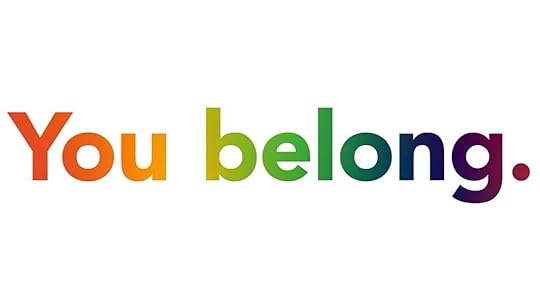
(Editor’s Note: Today’s article is brought to
you by
our
friends at WorkHuman
(formerly known as Globoforce). They
help organizations energize their cultures and unlock employees’ passion and
potential with
the
fastest-growing social recognition and continuous performance management
platform
. Enjoy the article!)
Employee retention continues to
be a major concern for organizations. With unemployment at historic lows,
organizations want to know that, when they hire someone, they’re going to stay.
It makes total sense. And I’d like to think by now we know the way to get
better retention is by giving employees the ability to do meaningful work in a
workplace where they feel respected by their manager and peers.
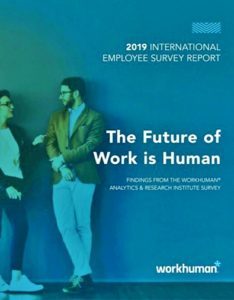
The good news is, if you’re
organization is doing just that – treating employees with respect and providing
them with the ability to contribute in a way that’s meaningful – then you’re on
the right track. According to WorkHuman’s latest survey “The
Future of Work is Human”,
the most important factor to employees is meaningful work. The second most
important factor is compensation, including benefits, and supportive
management. The third factor is company culture and a fun team.
I hope you’ll take a moment to download the
full report for two reasons. The first one I just mentioned. Companies focused
on providing respectful workplaces and meaningful work are going to see
positive results. The second reason to download the report is when employees
don’t feel that they’re getting the things it takes to create meaningful work
(i.e. good compensation and benefits, supportive management, fun team, etc.)
they have other options. And they’re not hesitant to start looking. The
WorkHuman survey stated that 21% of respondents are currently looking
for a new job.
Meaningful Work Isn’t a Millennial Thing
Before someone starts thinking, “Oh, it’s just
those Millennials.”, let me say that I believe what we’re seeing in today’s
market can’t be explained as a “Millennial thing”. I spoke to Jesse Harriott,
executive director of WorkHuman’s Analytics and Research Institute, about the
study and how age factors (or doesn’t factor) into the results. “We didn’t go into the
research with any pre-conceived notions about age differences – although it’s
well established that workplace attitudes can differ as workers age or between
generations. However, we do see a consistent thread across age groups that
‘meaningful work’ is rated as most important to an employee’s career.”
The reason that creating a
respectful workplace where people can do meaningful work isn’t a Millennial
thing is because the barrier isn’t a Millennial thing. In the report, the
reason that employees feel they can’t do their best work is because they don’t
feel safe. That’s the barrier. Employees won’t feel like they have
supportive management if they don’t feel safe. Employees won’t feel like they’re
working with a fun team if they don’t feel safe. And organizations might offer a
great compensation and benefits package, but if employees don’t feel safe, is
it really enough?
Right around the time WorkHuman shared their report with me, I ran across an article from the Society for Human Resource Management (SHRM) that reported inequality ranks low on global HR’s concerns. This made me realize the trend workplaces are facing. How can employees feel safe if they don’t feel that they’re equal? I felt like this article from SHRM aligned with a few of the findings in the WorkHuman report:
26% of employees have felt discriminated against during the course of their career
50% of women reported that a manager has taken credit for their work
50% of women in technology said hiring and promotion decisions are based on gender and/or race
100% of women in the hospitality industry said hiring and promotion decisions are based on gender and/or race
When asked why they felt discriminated against, the top responses included age, gender, race, political views, and sexual orientation.
But
what might have been even more interesting than these statistics about
discrimination in the workplace is that this isn’t the top reason that
employees said they don’t feel safe at work. So as bad as these numbers are…it’s
not the number one reason. The number one reason that employees don’t feel
safe at work is a toxic work culture. I asked Harriott if
they expected to see culture
as the number one reason employees don’t feel safe. “It’s not surprising that
employees report that toxic culture is the #1 reason they don’t feel safe. Psychological
safety is critical for employees to be productive, strive for excellence,
innovate and generally bring their best selves to the workplace. Toxic work
cultures are a breeding ground for things that undermine psychological safety:
Lack of recognition for good work,
Fear of failure,
Poor leadership,
Lack of trust, etc.”
Civility Training Can Improve Psychological Safety
This is the hard part. Some of
you are reading this and saying, “Of course, toxic work cultures are the
problem. Tell me the answer.” And some of you might want to know exactly what
defines a toxic work culture. Let’s start with the definition of a toxic work
culture. In addition to Harriott’s comments above, think of a toxic work
culture as one where people don’t practice kindness and respect. Where
employees aren’t civil to one another.
Which is
where civility training could be viewed as a possible solution. Christine
Porath is a tenured professor at Georgetown University and the author of
“Mastering Civility: A Manifesto for the Workplace”. She also has a TED talk on
“Why
being respectful to your coworkers is good for business”.
Porath
shared with me some statistics on how incivility has a direct impact on the
bottom-line. Some of them would be no surprise to you like 12% of employees
said they left a job because of uncivil treatment. But there were a couple that
surprised me. Like 25% admitting to taking out their frustrations on a customer
and 63% lost work time simply avoiding the toxic person. It’s
estimated that organizations lose about $6 billion a year because of workplace
incivility.
When it comes
to training, Porath emphasizes the need for organizations to start by defining
civility. “When establishing specific principles that you want employees
to follow in how they treat others, I’ve found that it’s beneficial to engage
them in an ongoing conversation about what civility means. These discussions
garner more support and empower employees to hold one another accountable for
civil behavior. Organizations can ask employees “Who do you want to be?” And
then ask what norms are right for their organization. The result is a ‘civility
code’, a set of rules for which they are willing to agree upon and hold one
another accountable.” This sets the stage for civility training because it
raises awareness and provides skills.
Retain
Employees by Focusing on Human Interactions
The
key to employee retention is having a culture where employees can do meaningful
work. Discrimination, toxic work cultures, and incivility are barriers to achieving
that goal. Again, I would recommend downloading WorkHuman’s “The
Future of Work is Human”
and checking out Christine Porath’s work on civility. It can help your
organization ensure that the workplace you’re creating is one where employees
can thrive.
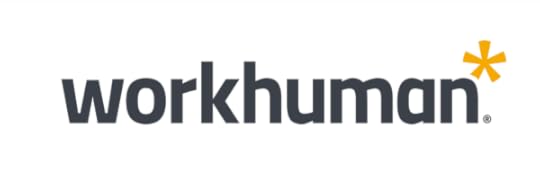
P.S. And don’t forget to mark your calendars
for WorkHuman Live in San
Antonio, Texas on May 11-14, 2020. Best-selling author Dan Pink has been
announced as a speaker. You
can get a $100 discount on registration by using the code WHL2020HRB100.
The discount code expires October 31, 2019 so book
now. Look forward to seeing you there!
The post Employee Retention: The Key to Meaningful Work is Psychological Safety and Civility appeared first on hr bartender.






October 13, 2019
There Is More To a Job Than the Work

I recently ran across an article titled, “The
CareerBliss 2019 Happiest and Unhappiest Cities to Work”.
I know, I know, it’s a total clickbait title. But I must admit there can be some
value even in clickbait titles, so I checked it out. While the actual list
didn’t surprise me, my takeaway from the article was worth consideration.
I learned a long time ago that where I live is
just as important as the work I’m doing. When we first moved to Fort
Lauderdale, I had never been there. All I knew was what I had seen on the TV
show “Cops”. I hate to say it, but that’s not a ringing endorsement to move
there. But I took the job anyway and I really enjoyed living in South Florida.
But sometimes we don’t put enough emphasis on the
connection between where we work and where we live. You can have a fabulous job
but if you live in a crappy city, how fabulous is your life really? That being
said, a couple of things to keep in mind here.
You have to define what makes a city wonderful or terrible. Everyone has different criteria for what makes a city special to them. You guys know that Mr. Bartender and I recently moved to North Florida. Neither one of us had ever lived there, so we came up with a list of what was important to us and used that as part of our research. The point being, when you’re not working, you have to spend time in the city where you live. Are you happy with it? And I don’t know that the only answer can be “Yes, because I have a job there.” Which leads us to the second consideration.
You also must decide what makes your job wonderful or not-so wonderful. Just like where we live, each of us has criteria for our jobs – the things we respect in an employer, the salary and benefits we would like to receive, the people that we want to be our co-workers, the manager we’d like to have, etc. None of us have the same criteria, which is why employers struggle at times putting together an employee value proposition (EVP). Because each individual’s needs and wants are different. AND take into account where the business is located.
My point is this – lists like the one I
mentioned in the opening paragraph – are reminders that jobs involve more than
just the tasks employees are responsible for. Organizations need to think about
the work environment, which includes where the job is located. And if the
employee has family, what the employee’s family thinks about where they live is
equally important. When we relocated to Cincinnati, my boss made sure that Mr.
B was happy with the decision as well. She didn’t have to do that. But she understood the importance of it.
In addition, the work / life connection could spark discussions about whether the job can be successful as remote work, which can open up the candidate pool. Or giving current employees the ability to live someplace that is wonderful (to them) while also doing a job they enjoy. I understand that not every job is eligible for remote work, and that might need to be addressed in a different way. Especially if an organization is having challenges hiring and retaining talent.
Bottom-line: Organizations must remember there’s a connection between work and life. And if possible, start thinking about how to showcase the city where the employee will live in addition to the company culture.
Image captured by Sharlyn Lauby while exploring the streets of Gainesville, FL looking for tea, not coffee.
The post There Is More To a Job Than the Work appeared first on hr bartender.






Sharlyn J. Lauby's Blog
- Sharlyn J. Lauby's profile
- 10 followers



